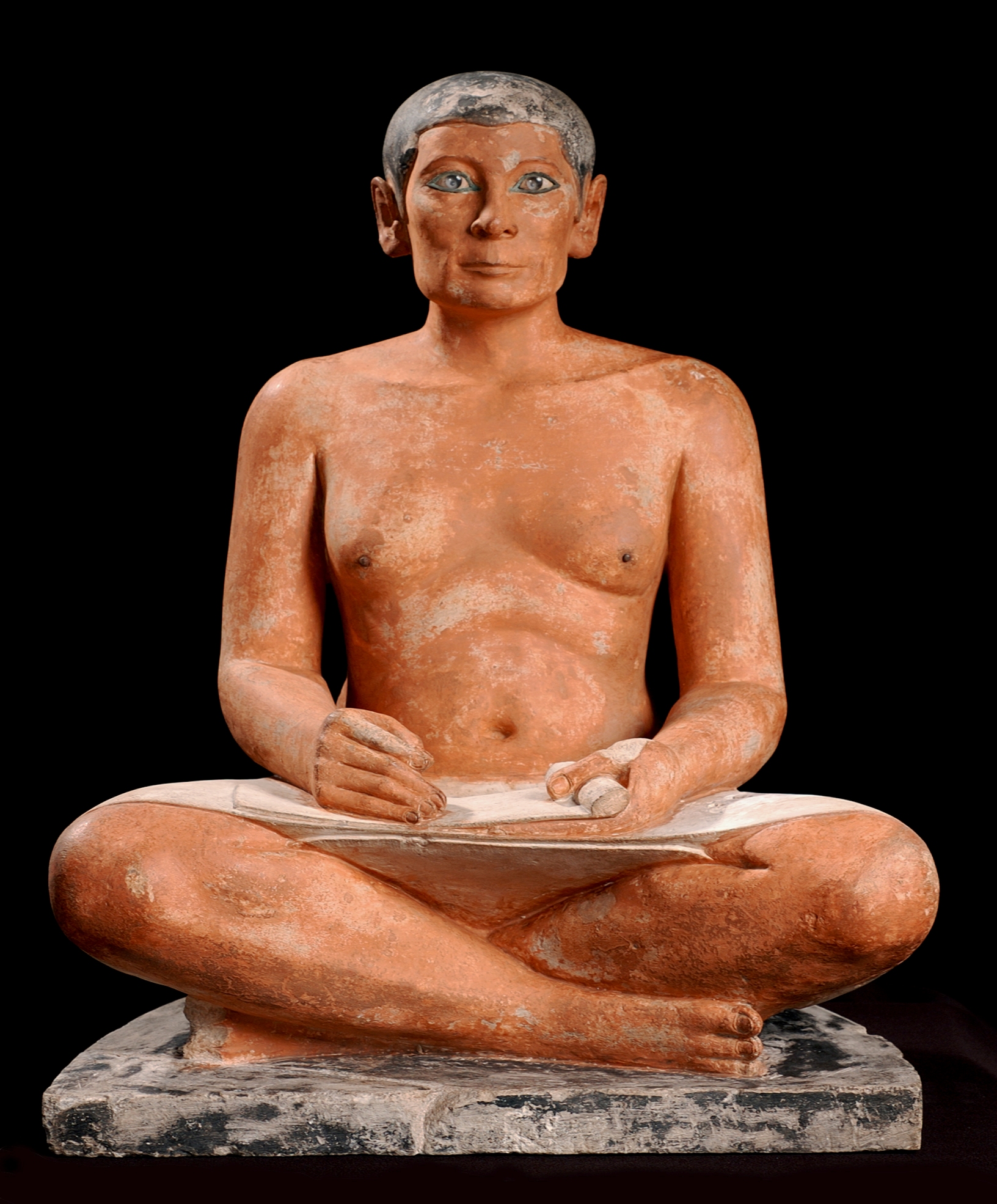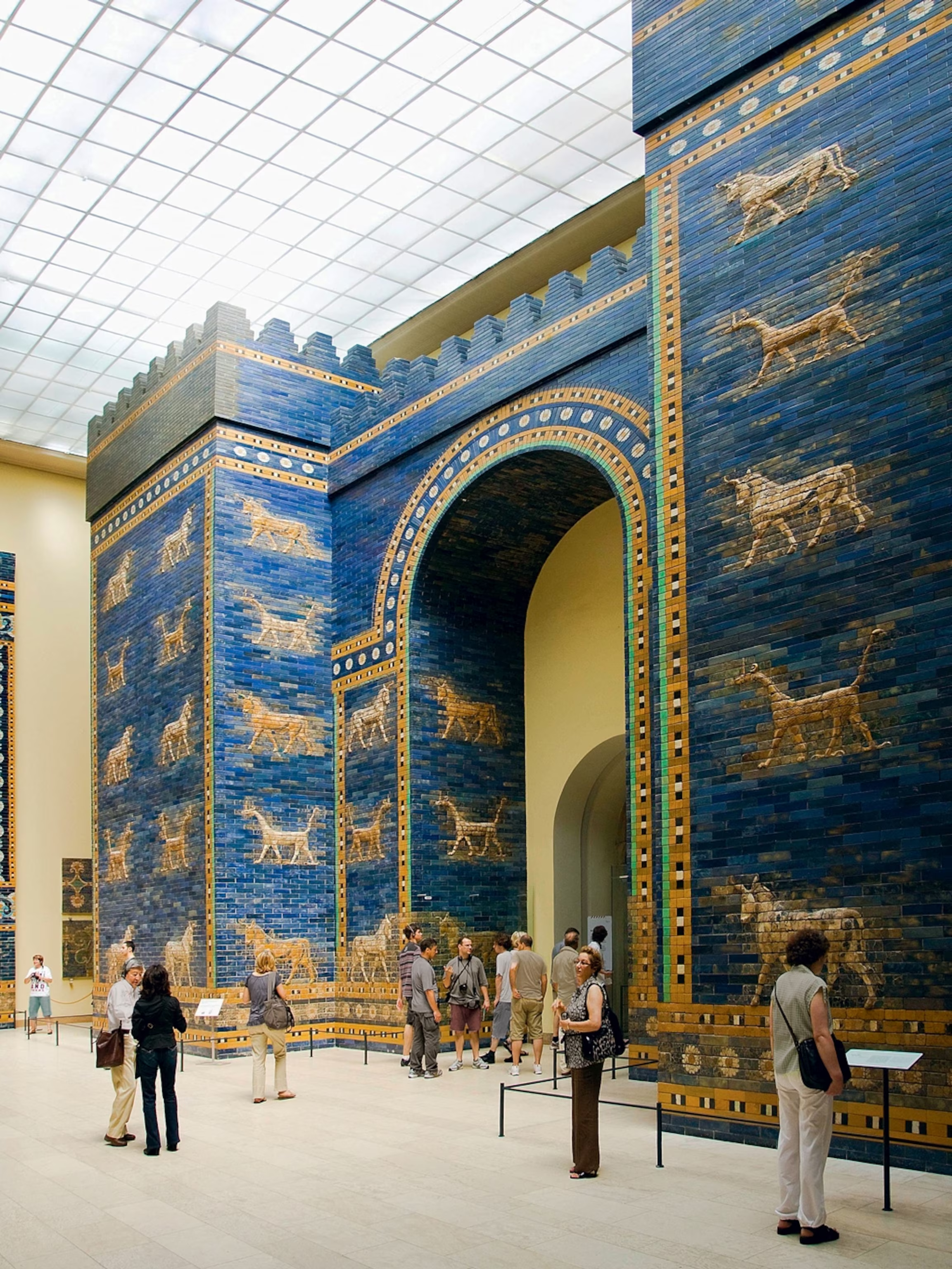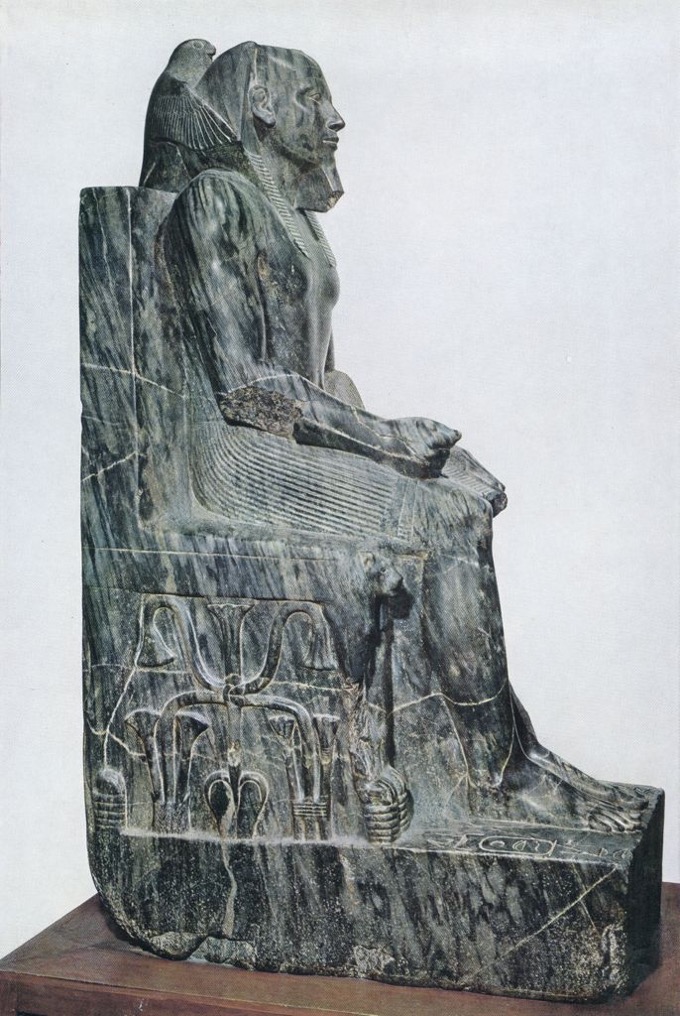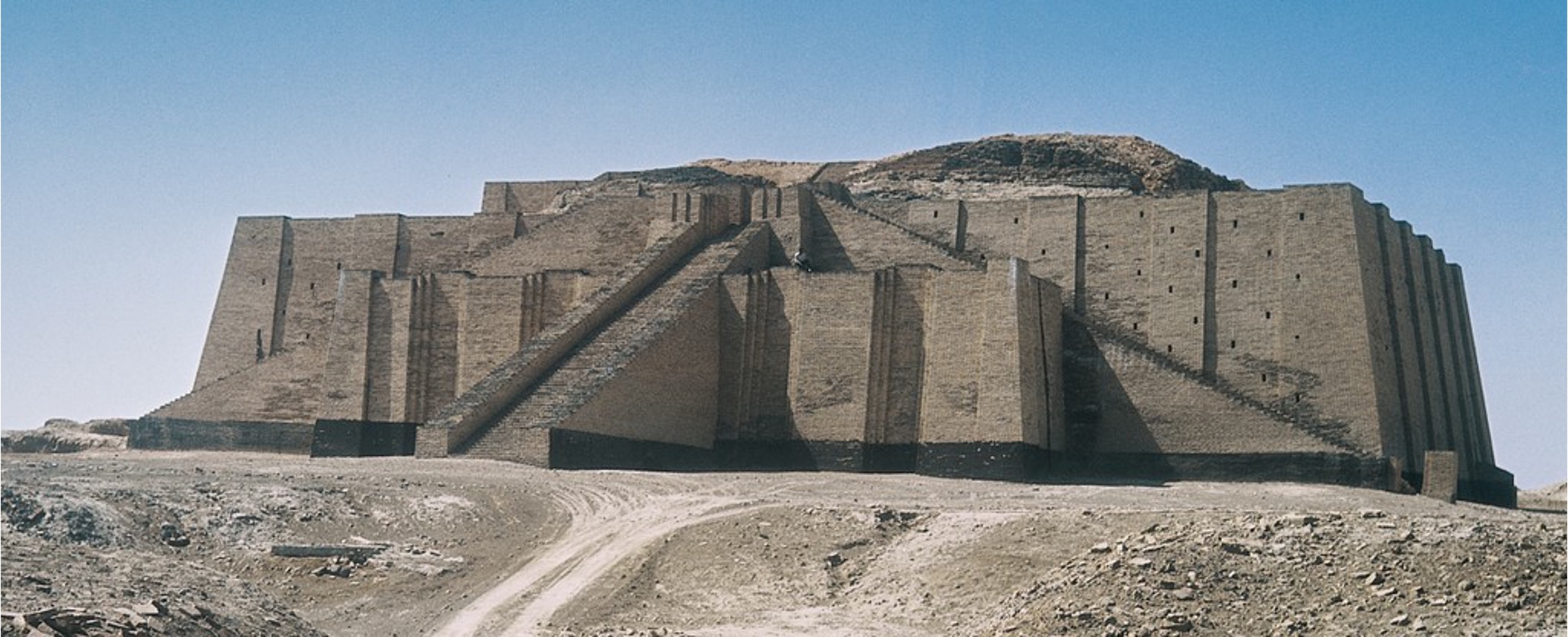ARTH 153: Pyramids to Cathedrals Exam 1
1/72
There's no tags or description
Looks like no tags are added yet.
Name | Mastery | Learn | Test | Matching | Spaced |
|---|
No study sessions yet.
73 Terms

Seated Scribe
Saqqara, Old Kingdom Egypt, ca. 2620-2500 painted limestone. Informal pose, natural face and relaxed belly rolls. Depicted in the act of writing. Found in the tomb of a government official.

Ishtar Gate
Babylon, ca. 575 BCE. Neo-Babylonian. Named for the goddess of love, fertility, and war. Patron was Nebuchadnezzar II. High relief sculptures of lions, bulls, and dragons. Glazed mud brick helped with preservation. Intended to both protect and show the power of the city.

Seated Kahfre
Old Kingdom Egypt, ca. 2520-2494 BCE. Represents the Pharaoh Khafre as idealized and muscular. Shows idea of timelessness, as the statue and his Ka are meant to live forever. Falcon represents Horus, beard and headress identify him as Pharaoh. Carved from gneiss, highly polished. Found in the Valley Temple in Giza. Carved with symbols from both lower and upper egypt, identifies him as uniter.

The Ziggurat of Ur
Neo-Sumerian Mesopotamia, ca. 2100 BCE, functioned as a religious temple dedicated to the moon god Nanna. Served as a center for worship and administrative activities. Patron was King Ur-Nam-mu. Constructed from mud bricks, multi-tiered step pyramid.
Votive Figure
Found in the Temple of Anu, Eshnunna. c. 2750-2600 BCE. Veined Gypsum. Size of the eyes and use of precious materials show importance. Hands positioned to hold a cup. Would have been positioned facing a cult statue of a deity. Way for donors to be in the presence of that deity.
Royal Standard of Ur
Royal Tombs, Ur c. 2600-2400 BCE. Wood, Lapis Lazuli, shell, red limestone. Three registers showing a procession to a banquet scene on one side. Hierarchy of scale shows seated figure most important. Another side has three registers showing a battle scene. Narrative/storytelling.
Great Lyre with Bearded Bull’s Head
Royal Tombs, Ur c. 2550-2400 BCE. Wood, gold, silver, lapis lazuli, shell, and bituman. Mostly naturalistic head, abstract registers. Registers show animals doing human activities. Humanistic beard. Possibly funerary rites or afterlife scenes.
Seated Statue of Gudea
Ruler of Lagash, c. 2120 BCE, Diorite. Neo-Sumerian. Votive statue dedicated to Ningishzida. Finely finished stone gives a sense of permanence. Traditional seated pose of a ruler, one of 27. Hands in a gesture of prayer/greeting. Cuneiform on the bottom dedicated to the deity.
Stele with the laws of Hammurabi
Babylon, c. 1780 BCE. Basalt. Importance of justice, laws inscribed for the public. Relief carving of Hammurabi and sun god Shamash, who gives him the ring and the rod. Legitimizes authority as a ruler.
Pyramids of Khufu, Khafre, and Menkaure
Old Kingdom Egypt, Fourth Dynasty, Giza c. 2575-2465. Expressions of state power, towns housed laborers. Funerary complexes, outer surface of white limestone.
Great Pyramid of Khufu
2600 BCE, Fourth Dynasty of the Old Kingdom. Funerary Monument for Pharoah Khufu. Limestone imported from other areas. Housed the body of the deceased Pharoah.
Great Sphinx
c. 2575-2465 BCE, Old Kingdom, Giza. Limestone. Mythological create with the head of the Pharoah Khafre and the body of a lion, originally cut from bedrock. Intended as a protector. Head adorned with headdress of the pharoah, originally painted.
Menkaure and Khamerernebty
c. 2490-2472 BCE, Old Kingdom, Fourth Dynasty, Giza, Menkaure Valley Temple. Greywacke. Nearly life sized statue of Pharoah Menkaure and his queen. Idealized, youthful, muscular bodies. Wears the headdress and fake beard of a pharaoh, originally painted. Follows Egyptian standards for human bodies. Idea of the Pharoah being eternal.
Akhenaten and Nefertiti with their three daughters
c. 1345 BCE, Amarna Period, 18th Dynasty, New Kingdom. Limestone House Altar. Depicts Pharoah Akhenaten and wife Nefertiti with their three children. Seated under god Aten and his sunrays. United Egypt under a common deity. Informal compared to other Egyptian art. Elongated proportions of head and neck, Akhenaten has both male and female features. Stylistic break from Old Kingdom Egypt.
Bust of Nefertiti
c. 1345 BCE, Amarna Period, Egypt. Created by court sculptor Thutmose. Limestone, gypsum, crystal, and wax. Identified by crown. Elongated neck. Naturalistic, heightened beauty.
Colossal Statue of Akhenaten
c. 1353-1336 BCE, Amarna Period, 18th Dynasty of Egypt. Sandstone. Traditional headdress and fake beard identify him as a pharaoh, holds crook and flail. Androgynous physical characteristics. Found at Karnak.
Death Mask of Tutankhamun
c. 1323 BCE, New Kingdom Egypt, 18th dynasty. Death mask, gold, lapis lazuli, other precious materials. Found in an intact tomb in the Valley of the Kings. Died young.
Tutankhamun’s Painted Chest
c. 1340 BCE, New Kingdom, Egypt 18th-19th dynasty. Painted wood. King pursuing wild animals on one side. King as a sphinx treading on his enemies. King in a battle against Nubian enemies. plastered, painted, and inlaid. King has a youthful, muscular body. three registers
Monumental Pylon of Ramesses II
c. 1279-1213 BCE. New Kingdom, Egypt. Sandstone, Luxor Temple Complex. Sunken relief of Ramesses II’s victory at battle of Kadesh. Protect the temple and promote his accomplishments.
Luxor Temple Complex
c. 1400 BCE, Funerary complex of Thebes. Dedicated to rejuvenation of Kingship. Built by Amenhoptep II, Tutankhamun and Ramesses II. Built from sandstone. Peristyle court and complex of halls and chambers, double row papyrus columns, pylons and colonnade.
Obelisk- Luxor Temple Complex
c. 1250 BCE, portal of the Luxor Temple, pink granite. Hieroglyphic text about Ramesses II.
Colossal Statues of Ramesses II
c. 1279-1213. 19th dynasty, Egypt. Granite. Portrait of the Pharoah, stood at the first pylon of Ramesses II.
Temple of Amun
c. 1550-1070 BCE. New Kingdom, Egypt. Temple complex of Karnak, dedicated to god Amun-Re. Location for the cult image of Amun, place for the god to dwell on earth. Hypostyle hall.
North Entrance to Knossos Complex
c. 1700-1370 BCE, Crete, Greece. Two raised colonnades known as Bastions. Could have been a place to trade goods, called the customs house. Open air passage, relief frescoes.
Bull-leaping Fresco
c. 1400 BCE, palace of Knossos, Crete, Greece fresco. Plaster art work. 3 figures leaping over a bull, or a continuous narrative of one figure. Bright colors. Depicts a ritual/ festival, bulls important in Minoan culture.
Bull’s Head Rhyton
c. 1550-1500 BCE, Knossos, black steatite, jasper, mother of pearl. Ritual vessel, held liquid that was poured from the bull’s mouth. Vivid realism.
Minoan Woman or Goddess
c. 1350 BCE, Knossos, Crete, Greece. Probably located in palace of Knossos, sacred knot at the back of her neck, resembled woman from paris. Rendered in color and detail. Knot designates her as a holy woman
Snake Goddess
c. 1600 BCE, Knossos, Crete, Greece. Elaborate clothes, bare chest. Ceremonial use, shows importance of clothing.
Marine Style Octopus Flask
c. 1500-1450 BCE, Palaikastro, Crete, Greece, Ceramic.. New palace period pottery. celebrates the sea, not much attention to realism, fluid and dynamic, complements the shape of the vase, love for the sea.
Lion Gate
c. 1300-1250 BCE, Mycenae, Greece, Limestone relief panel. Relief triangle above post and lintel system. Two lions protect central column (represents the city). Wall made of cyclopean masonry.
Exterior of the Treasury of Atreus
c. 1300- 1250 BCE, Mycenae, Greece. Built into a mountain. Post and Lintel system with a relieving triangle, ashlar masonry.
Interior of the Treasury of Atreus
c. 1300-1250 BCE, Mycenae, Greece, ashlar masonry, beehive shaped tomb, built into a hillside, keystone at the top, corbelled dome.
Grave Circle A
c. 1600 BCE, Mycenae. Shaft graves, burial complex. originally built outside the city, later enclosed when fortification was extended. funerary gifts found, many of them gold, riches of the area.
Funerary Mask from Grave Circle A
c. 1550-1500 BCE, Mycenae, greece, beaten gold. Indicate honor, wealth and status of the person, evidence of elite warrior class. each mask had distinctive features.
Inlaid Dagger Blade with Lion Hunt
c. 1600-1500 BCE, Mycenae, Greece, Bronze inlaid with gold, silver, and niello. reference to military/ hunting activities. reminder of the dangers of the hunt, Strong Minoan influence, flying gallop, imported goods, show far reaching connections
Warrior Vase (krater)
c. 1300 BCE, Mycenae, Greece, Terracotta. Line of Foot soldiers marching to battle, Woman gives gesture of mourning, composite viewpoint, eye is frontal, face in profile, organized composition
Reconstruction of the sacred center at Chavin de Huantar
c. 900-200 BCE, Peru. Ceremonial building, U shaped with a sunken patio, space for religious rituals, two interconnected buildings, low relief sculptures of supernatural figures, uses ashlar masonry, temple facade meant to awe visitors. constructed using post and lintel system, pilgrims came from all over region.
Lanzon Stele
c. 900-200 BCE, Old Temple, Chavin de Huantar, Peru, Granite. Located in the old temple, looks like the tip of an arrow, located at the center of an underground passageways, complex imagery, figure with combination of animal and human figures, contour rivalry.
Raimondi Stele
c. 800-200 BCE, Main Temple, Chavin de Huantar, Peru, Granite. Moved from original location, low relief carving/ incising lines, monolith, perfect symmetry, highly abstract, contour rivalry, combo of human and animal figures, staff god, likely related to shamanism, connected to forces of nature, express through shapes of different types of animals
Pectoral
c. 900-500 BCE, Chavin de Huantar, gold. meant to be placed on the chest of an individual, abstracted, figurative motifs
La Venta, reconstruction drawing
c. 900-400 BCE, Mexico, man-made earthen pyramids, religious functions instead of funerary, no internal structures, imitations of mountains/ volcanos. civic/ ceremonial center, mosaics with expensive/ imported materials
Colossal Head
c. 900-400 BCE, La Venta, Basalt, individual features, portraits of patrons, transported from other areas, areas in low and deeper relief, naturalistic approach.
Altar 4
c. 900-400 BCE, La Venta, Basalt, Thrones, ruler would set on them for ceremonies. Use of both high and low relief, center holds a deep carving of a cave with a person emerging from it. connects to power of the ruler, related to the origin of civilizations, could indicate the underground.
Offering No. 4
c. 900-400 BCE, La Venta, sepentine, jadeite, and granite. Figurines and celts, placed like they were in community/ conversation, faced towards the center. more naturalistic, 3D features. Elongated heads reserved for rulers or individuals who held important positions, associated with the maize god, ie. corn shaped heads
Ceremonial Axe Head in the form of the Maize God
c. 900-400 BCE, La Venta, Jade, ritual object connected to this deity, shows eating habits of the community, Maize had to be domesticated and cultivated, allowed for flourishing of these cultures
Stairway, Apadana
c. 520-465 BCE, Persepolis. People from conquered territories brought tribute to the emperor, Persian military represents support for the emperor, style assimilated from other cultures, Animal fight (Assyrian Art), Organized narrative using register (Assyrian). Ahura Mazda represents official religion of the empire. Concept of representing figures in full side profiles. Originally painted
Bull Capital from Apadana Palace
c. 520-465 BCE, Persepolis. Bulls common motif. Enormous hypostyle halls. Imported artisans that were experienced in stone work.
Persians and Medes, Processional frieze
c. 521-465 BCE, Persepolis, Limestone. Representations of conquered people’s bringing tribute to the emperor. Dressed in distinctive clothing with characteristic animals and items from their respective cultures. Persian nobles in pleated skirts, Medes in round caps, knee length tunic, and trousers.
Armenian Tribute Bearer
c. 520-465 BCE, Relief from eastern stairs of Apadana in Persepolis. Carries a metal vessel with two handles and a Homa (griffin).
Gate of Xerxes
c. 475 BCE, Persepolis. entrance to the complex, Hybrid, mythological animals, called Lamassu by Assyrians. Protectors of the city, symbolic protection instead of protective architecture. confident in their military power.
Rhyton in the form of a winged lion
c. 5th-4th century BCE, Hamadan, gold. Shows the wealth of the ceremonies that took place in the Apadana. Intricately carved, great gold smithing skill.
Akropolis
c. 5th century BCE. Athens, Greece. Ceremonial/ ritual site. Ransacked by the Persians in 580 BCE, Statesman Pericles rebuilt it. Intended to show the power of Athens. Religious center dedicated to cities patron goddess, Athena.
Parthenon
c. 447-438 BCE, Marble, designed by Iktinos and Kallikrates. Post and Lintel construction. Dedicated to Athena, housed colossal statue of Athena along with many statues and intricate decoration. Ionic and doric order, surrounded by columns, cella divided into two portions. Built with the person viewing it in mind, relates to humanism.
Propylaia
c. 437-432 BCE, Doric Building complex. served as the gateway to the Akropolis. Designed by Mnesikles. Processional route through the Propylaia into the Akropolis.
Pinakotheke
picture gallery, formed left wing of the Propylaia, written about by Pausanias. No remains
Erechtheion
c. 421-405 BCE. Marble, aka Temple of Athena Polias. Ionic order, housed cult statue of Athena. Caryatid porch.
Temple of Athena Nike
c. 427-424 BCE, Marble. designed by Kallikrates. Dedicated to Athena and Nike, colonnaded portico at front and back.
Centauromachy
c. 447-438 BCE, marble. metope from the south side of the Parthenon. carved plaques. Artist was probably Phidias. fight between centaurs and lapiths at a wedding.
Details from Panathenaic Festival Procession frieze
Parthenon freize. Depicts the Panathenaic festival procession in great detail. Festival commemorates birthday of Athena. Overlapping horses create depth. Side profile view. Attention to detail in clothing and bodies. Naturalism! Movement and depth.
Helios and his Horses
East pediment of the Parthenon. Naturalistic, idealized bodies, focus on humanism, extremely detailed, perfection of the male nude.
Three Goddesses
East Pediment of the Parthenon. represented the scene where Athena was born from the head of Zeus. Varied posture. Naturalistic modeling of anatomy, complex draperies. Might be Hestia, Dione and Aphrodite.
Caryatids
c. 421-405 BCE, Marble, on the high stylobate on the south porch of the Erechtheion. female figures that serve as support for the entablature of a building. Contrapposto poses. Represent young women.
Nike Adjusting her Sandal
c. 421 BCE. High relief, marble. Parade of winged figure of Nike, sense of balance in her awkward pose, wings act as counter balance. Could symbolize marriage, removing her sandel to walk on sacred ground, or just in a simple, everyday gesture. Humanized Nike, paves way for late classical style with focus on individualism and everyday scenes.
Doryphoros (The Spear Bearer)
c. 450-440 BCE, Polykleitos. Developed his Kanon (treatise on ideal poroprtions for sculpture). Bronze, lost wax cast. Advanced stage of contrapposto, depicts male warrior holding a spear, muscular figure, naturalistic youth. sense of subtle movement. demonstrated greek ideals of youth and beauty. Ideal for the male body were athletes or warriors
Artemision Zeus
c, 450-440 BCE. Bronze. Bronze allowed for more poses, more tensile strength. Modified warrior pose, hints at future movement, psychological intensity.
Artemis and Apollo slaying the children of Niobe
c. 450 BCE, Athenian red-figure calyx Krater. Used for mixing wine and water. unusual visuals for drinking party. Gods avenge their mother, placed at different heights to give the illusion of depth. No emotion on their faces despite emotional subject. Same naturalistic elements seen in sculpture.
Warrior taking leave of his wife
c. 440, Athenian white-ground lekythos. White-ground technique, outlines and detail are painted in color onto a white slip background. Women played important role in religious rituals for the dead. Use of different colors. High levels of proficiency in ceramics and paintings. Documentary source.
General View of Pit 1, Terracotta Army
210 BCE, Tomb of Qin Shihuangdi. Terracotta, 5 feet 10 inches. Meant to be underground and sealed off. Soldiers serve the emperor in the afterlife. Displays military prowess of Qin Empire. Follows Legalism philosophy. Ordered, standardized system.
Armored Warrior
210 BCE, Terracotta. Assembled modularly, pieces built by unskilled laborers and then assembled. Overseen by a skilled artisan. Reflects standardization and division of labor. Not identical, some variation between figures. Costume changes based on rank, individualism in the face.
Charioteer
210 BCE, Terracotta
Kneeling Arches
210 BCE. Terracotta. Different facial features. In a position to confront the enemy if needed.
Cavalryman and Saddle Horse
210 BCE, Terracotta. Man is naturalistic, the horse is less so, especially with regards to scale. Qin army known for their imposing cavalry. More concerned with the horse as an attribute of the human.
Bronze Chariot with four horses
210 BCE. Life sized, stands at attention, naturalistic, originally painted, very close replica of actual military gear used at the time, the soldiers were intended to be functional. High standing of a member of the military